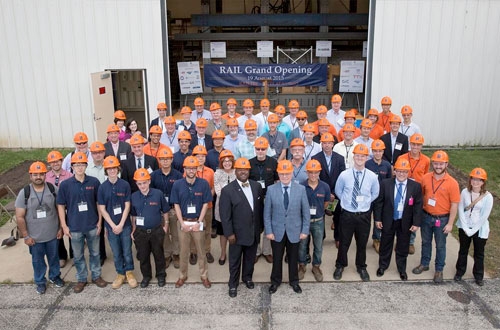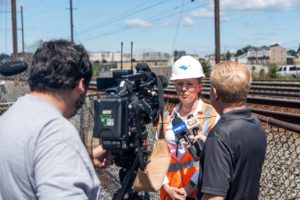UIUC opens RAIL to advance better track designs
Written by Mischa Wanek-Libman, editor
The University of Illinois at Urbana-Champaign (UIUC) hosted a ribbon cutting ceremony for its Research and Innovation Laboratory (RAIL) located at the Harry Schnabel, Jr., Lab.
The university said the work being done at RAIL is critical as the industry continues efforts to move freight across the continent safely, efficiently and economically and with rail transit systems are undergoing substantial expansion.
The 3,500-square-foot lab, which is part of the UIUC’s Rail Transportation and Engineering Center (RailTEC), began initial operations in 2014 and recently became fully functional. It was established through grants and support from the U.S. Department of Transportation’s Office of the Assistant Secretary for Research and Technology, the Federal Railroad Administration, railroads and rail industry suppliers.
“This laboratory is an important new tool to develop a fundamental understanding of how track components and track systems respond to heavy-axle-loads, high-speed trains and rail transit vehicles,” said Christopher Barkan, who is a professor and George Krambles Faculty Fellow in the Department of Civil and Environmental Engineering, and Executive Director of RailTEC. “Such understanding is critical to improved future designs.”
The August 19th ceremony included dignitaries from government, such as Gregory Winfree, assistant secretary for Research and Technology for the USDOT; Michael Franke, senior director of State Government Contracts for Amtrak and Joseph Leader, senior vice president for New York City Transit.
“We can experimentally control key variables that relate to how the track structure is loaded, and measure and quantify its response under various conditions,” added Riley Edwards, a senior lecturer and research scientist. “These specific laboratory capabilities did not previously exist in North America.”
The university notes that more recent investment in RAIL is for research on rail transit tracks due to expansion of these systems in such cities as New York, Denver, Salt Lake City, Seattle and others. Next month RailTEC will begin a new $2.4 million project for the FTA developing improved track components for rail transit systems. The project, “Resilient Concrete Crosstie and Fastening System Designs for Light Rail, Heavy Rail, and Commuter Rail Transit Infrastructure,” involves partners that include the American Public Transportation Association, New York City Transit, MetroLink (St. Louis), TriMet (Portland, Ore.), Metra (Chicago), Amtrak, CXT Concrete Ties Inc., GIC Inc., Pandrol USA, Amsted RPS and Hanson Professional Services Inc.
“We’re adapting methodologies and procedures that we’ve developed through prior research in the railroad industry and applying them to solve rail transit problems,” said Edwards. “As is the case with the railroad research, the objective is to engineer transit infrastructure components so they better perform their intended function and at the same time reduce costs for these public agencies.”
“Thanks to the research conducted at RAIL, we will see better designed track and components,” concluded Barkan. “It will be engineered to withstand the increased demands on the track system from higher speeds and heavier-axle-loads. If you’re a passenger, it will mean you’re riding on safer and more reliable infrastructure, that is less likely to have outages that delay service.”





